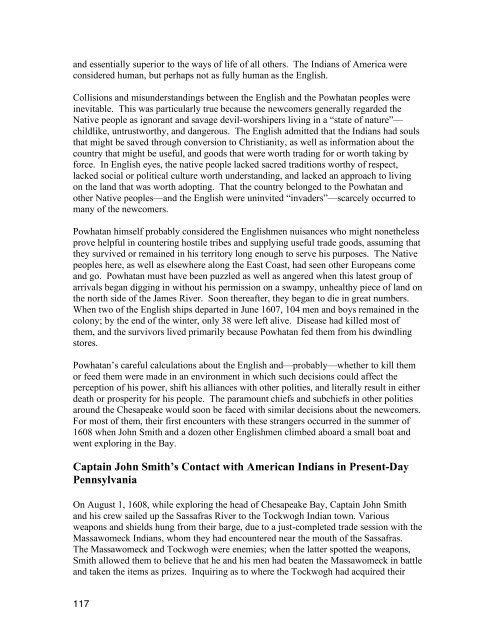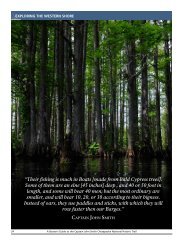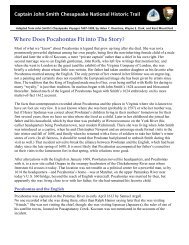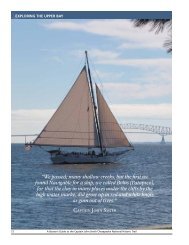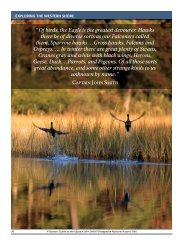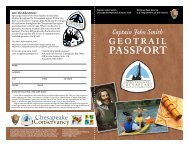Draft Interpretive Plan Join the adventure! - Captain John Smith ...
Draft Interpretive Plan Join the adventure! - Captain John Smith ...
Draft Interpretive Plan Join the adventure! - Captain John Smith ...
Create successful ePaper yourself
Turn your PDF publications into a flip-book with our unique Google optimized e-Paper software.
and essentially superior to <strong>the</strong> ways of life of all o<strong>the</strong>rs. The Indians of America were<br />
considered human, but perhaps not as fully human as <strong>the</strong> English.<br />
Collisions and misunderstandings between <strong>the</strong> English and <strong>the</strong> Powhatan peoples were<br />
inevitable. This was particularly true because <strong>the</strong> newcomers generally regarded <strong>the</strong><br />
Native people as ignorant and savage devil-worshipers living in a “state of nature”—<br />
childlike, untrustworthy, and dangerous. The English admitted that <strong>the</strong> Indians had souls<br />
that might be saved through conversion to Christianity, as well as information about <strong>the</strong><br />
country that might be useful, and goods that were worth trading for or worth taking by<br />
force. In English eyes, <strong>the</strong> native people lacked sacred traditions worthy of respect,<br />
lacked social or political culture worth understanding, and lacked an approach to living<br />
on <strong>the</strong> land that was worth adopting. That <strong>the</strong> country belonged to <strong>the</strong> Powhatan and<br />
o<strong>the</strong>r Native peoples—and <strong>the</strong> English were uninvited “invaders”—scarcely occurred to<br />
many of <strong>the</strong> newcomers.<br />
Powhatan himself probably considered <strong>the</strong> Englishmen nuisances who might none<strong>the</strong>less<br />
prove helpful in countering hostile tribes and supplying useful trade goods, assuming that<br />
<strong>the</strong>y survived or remained in his territory long enough to serve his purposes. The Native<br />
peoples here, as well as elsewhere along <strong>the</strong> East Coast, had seen o<strong>the</strong>r Europeans come<br />
and go. Powhatan must have been puzzled as well as angered when this latest group of<br />
arrivals began digging in without his permission on a swampy, unhealthy piece of land on<br />
<strong>the</strong> north side of <strong>the</strong> James River. Soon <strong>the</strong>reafter, <strong>the</strong>y began to die in great numbers.<br />
When two of <strong>the</strong> English ships departed in June 1607, 104 men and boys remained in <strong>the</strong><br />
colony; by <strong>the</strong> end of <strong>the</strong> winter, only 38 were left alive. Disease had killed most of<br />
<strong>the</strong>m, and <strong>the</strong> survivors lived primarily because Powhatan fed <strong>the</strong>m from his dwindling<br />
stores.<br />
Powhatan’s careful calculations about <strong>the</strong> English and—probably—whe<strong>the</strong>r to kill <strong>the</strong>m<br />
or feed <strong>the</strong>m were made in an environment in which such decisions could affect <strong>the</strong><br />
perception of his power, shift his alliances with o<strong>the</strong>r polities, and literally result in ei<strong>the</strong>r<br />
death or prosperity for his people. The paramount chiefs and subchiefs in o<strong>the</strong>r polities<br />
around <strong>the</strong> Chesapeake would soon be faced with similar decisions about <strong>the</strong> newcomers.<br />
For most of <strong>the</strong>m, <strong>the</strong>ir first encounters with <strong>the</strong>se strangers occurred in <strong>the</strong> summer of<br />
1608 when <strong>John</strong> <strong>Smith</strong> and a dozen o<strong>the</strong>r Englishmen climbed aboard a small boat and<br />
went exploring in <strong>the</strong> Bay.<br />
<strong>Captain</strong> <strong>John</strong> <strong>Smith</strong>’s Contact with American Indians in Present-Day<br />
Pennsylvania<br />
On August 1, 1608, while exploring <strong>the</strong> head of Chesapeake Bay, <strong>Captain</strong> <strong>John</strong> <strong>Smith</strong><br />
and his crew sailed up <strong>the</strong> Sassafras River to <strong>the</strong> Tockwogh Indian town. Various<br />
weapons and shields hung from <strong>the</strong>ir barge, due to a just-completed trade session with <strong>the</strong><br />
Massawomeck Indians, whom <strong>the</strong>y had encountered near <strong>the</strong> mouth of <strong>the</strong> Sassafras.<br />
The Massawomeck and Tockwogh were enemies; when <strong>the</strong> latter spotted <strong>the</strong> weapons,<br />
<strong>Smith</strong> allowed <strong>the</strong>m to believe that he and his men had beaten <strong>the</strong> Massawomeck in battle<br />
and taken <strong>the</strong> items as prizes. Inquiring as to where <strong>the</strong> Tockwogh had acquired <strong>the</strong>ir<br />
117


